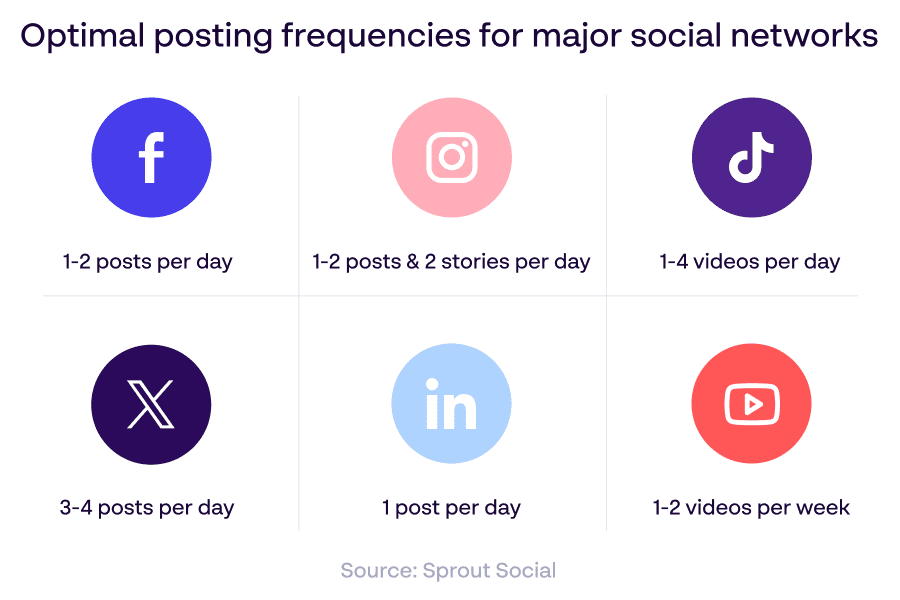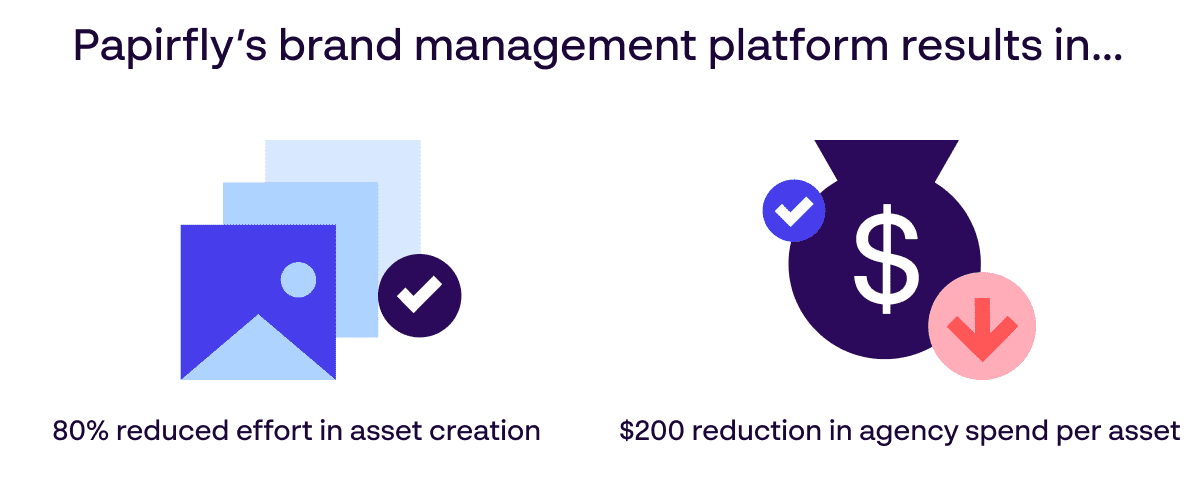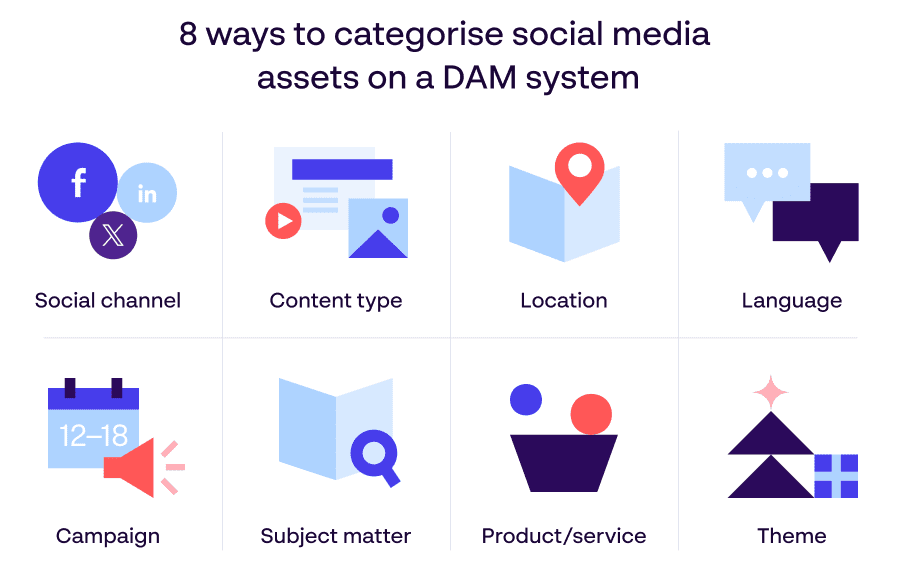For better or worse, social media networks are an integral part of our lives – and channels that modern marketers must master.
Why? Because over 5 billion people worldwide use social media channels at least once per month – a figure that is expected to touch 6 billion by 2027. As a result, it’s one of the main avenues for brands to communicate directly with their consumers, tell stories and build trust with their audience.
That makes a strong, consistent social media brand incredibly valuable. Not only does it ensure your audiences can recognise your brand’s identity – they can also get to know your values. Any break in uniformity risks eroding these delicate relationships.
In this essential guide, we’ll outline how you can sustain a consistent brand voice across your social profiles, and share our top tips to enhance your long-term social media marketing strategy.
What is social media branding?
Social media branding is how you utilise your social networks to grow, promote and evolve your brand’s identity. Put simply, it’s how you choose to portray your brand on social media.
With how prevalent these platforms are in modern society, this is very likely where someone first encounters your brand. So, the content on your profiles must be crafted and curated to clearly share your values and personality, in the same way you would approach your website or general advertising.

What are the key elements of social media branding?
An effective social media brand must get several key aspects correct to successfully resonate with audiences.
Consistency: You must maintain a consistent tone, style, and visual identity across your social media posts to reinforce brand recognition and trust.
Content creation: You must develop and share relevant and compelling types of content, including imagery and video content, that connects with people and aligns with your branding.
Engagement: You must actively interact with followers, responding to comments, messages, and mentions to foster relationships and build long-term loyalty.
Brand voice: You must establish a distinct, authentic brand voice that reflects your organisation’s personality and values.
Community building: You must cultivate a community through user-generated content (UGC) and create opportunities for your followers to participate and support your brand.

While each element is important, brand consistency is the most essential piece of the puzzle – and often the most challenging to enforce.
The importance of social media brand consistency
Consistency is the base for any stable, trustworthy relationship. The relationship between you and your social media followers is no different.
Today’s consumers want to trust the brands they buy from. They want to feel they share the same values, speak the same language, and have comparable priorities. Especially on social media, which has always been a more “personal” environment, many people use these platforms to understand brands rather than buy from them.
This is why brand consistency is so vital on these channels. If your followers get mixed messages from your content, or markedly different experiences when they communicate with your brand through social media, they start to question what your brand stands for.
Questioning breeds mistrust, and mistrust is a slippery slope to losing followers and brand recognition.

Beyond damaging the trust of your followers, an inconsistent social media presence can also make your organisation appear unprofessional. If your posts deviate from your primary brand colours, mix up typographies or constantly change formats, it reflects a lack of internal organisation. And nobody wants to buy from a brand that appears disjointed.
Further problems caused by inconsistency on your social media platforms include:
- Followers failing to recall your brand when in the market for your products and services
- Reduced engagement and interaction with your posts from your followers
- Less effective paid social campaigns alongside your organic content
- Weakening your overall brand equity

How often should I post on social media to maintain brand consistency?
Brand consistency doesn’t simply apply to the quality of your content or how you communicate with your audiences. You should also be consistent in how frequently you post on social media.
People are creatures of habit – if they enjoy your content, they will carve out the time to seek it out. But, if you take a scattergun approach to scheduling content, users won’t be able to track it accordingly. Think of it like your favourite TV show – if new episodes came out at a random date and time each week, would you be following it as closely?
With so many social media channels, each with different audiences and algorithms, how often you post must be adjusted accordingly. Here’s a quick guide based on best practices:

Of course, your understanding of your audience will dictate whether you post more or less frequently. Nevertheless, a set calendar for when and where your posts are published will help ensure a consistent experience for your followers.
8 tips for building a consistent social media branding strategy
1. Lock down your brand identity and goals
First, the key to consistency on social media is having your purpose, mission, values and identity nailed down before sharing your first post. Every relevant person on your team, from your dedicated social media brand manager, to marketers in your local outlets, should fully understand what your brand stands for.
Now, your social media brand may vary slightly from your other marketing channels depending on your goals for these platforms. Do you want to raise brand awareness? Do you intend to generate leads? Is it simply a means for your customers to message your brand?
Whatever your social media brand represents, centralise it in one all-encompassing brand hub. From here, your teams worldwide can access digital brand guidelines, style guides and more to ensure any marketing materials they produce align with your core branding and overarching goals.
2. Establish your target audience
Next, consider your target audience – who are your posts communicating with?
- How old are they?
- Where do they spend their time online and offline?
- Which platforms are they likely to use?
- What are their pain points?
This may not be straightforward to answer as different social channels attract different audiences. For instance, younger consumers lean towards platforms such as TikTok and Instagram, while Facebook has now cultivated an older user base.
Establishing personas for every social network you intend to use will help keep your messaging aligned with their specific wants and preferences, while remaining within your brand guidelines.
3. Define your social media channels
Based on what you know about your audiences, this should help you define what channels to devote your efforts to. It’s unlikely your ideal customers will be active on every social channel, so this will help you streamline your content and focus your attention on the areas where you stand to make the greatest gains.
For example, LinkedIn is a go-to platform for B2B businesses, but may hold less value for B2C organisations.
Being selective with your social media channels also empowers your teams to fully understand these platforms – their nuances, their best-performing types of content, their ideal posting times. This knowledge will allow you to optimise your content accordingly, so it reaches the right audiences at the right times, all while telling a compelling, consistent story.

4. Create a social content calendar
As we noted earlier, consistency applies just as much to the frequency of your posts as it does to the quality of your visual content. With this in mind, creating a social calendar helps ensure that your channels maintain the regularity your audiences expect.
Here are a few best practices when setting up your schedule:
- Develop a variety of content themes and pillars (educational, entertainment, promotional, etc.) and spread these out to keep your feeds engaging
- Research each platform you use to determine their most optimal posting times
- Follow the 80/20 rule when producing content, with 80% of your content providing value and 20% promoting your goods or services
- Leave capacity for user-generated content, special announcements and more
- Highlight noteworthy holidays, relevant events and awareness dates to tailor content for these occasions
5. Build social post templates
Creating consistent brand assets demands dependable templates. While easily accessible brand guidelines help keep everyone on the same page, intelligent templates make this second nature for your social media teams, ensuring they cannot deviate from your visual identity.
As well as locking down the position of your logo, brand colours, design elements and more, branded design templates enable you to create real-time marketing materials for your various channels and locations. Your templates can match the optimal size and layout of each platform, and enable users to switch up the language or imagery for different countries and cultures.
Fundamentally, templates empower your social media marketers to work faster, confidently and cost-effectively, all while preventing inconsistencies.

6. Produce communication guidelines
Consistency on social media goes beyond your day-to-day feeds – it’s how you communicate with followers one-to-one. Any difference in tone or experience when answering a user’s comment or replying to a private message can be just as damaging to their overall impression of your brand.
By developing communication guidelines for those responsible for engaging with your followers, you can keep these messages consistent with your values and tone of voice. This may include set responses for particular scenarios, such as how to respond to a complaint or negative comment, or what user posts it’s okay for your platform to share and comment on.
Responsive engagement is integral to the performance of your social media strategy – and an approach that will keep your tone aligned with your overarching goals and identity.
7. Set up a home for your digital assets
If your company has teams spread worldwide, consistency is a real challenge. It only takes one rogue post to disrupt your communications and damage your reputation with your followers. That’s why it’s useful to have everyone in your organisation working from the same bank of digital assets.
Intelligent templates and a central brand hub can help achieve this, but Digital Asset Management (DAM) provides an added layer of protection. These solutions provide a repository where users can store and access all approved social assets, and from here adapt them for local audiences.
With this “single source of truth” for your social media brand, you can publish on-brand collateral across any platform, and maintain a birds-eye view over the consistency of your assets. Plus, these digital libraries enable you to tag and categorise assets, so your teams can find what they need faster and easier:

By managing your digital assets effectively, you can lock down consistency across every social media channel and campaign, without proofing-related bottlenecks.
8. Monitor your social media channels
Finally, you should monitor and track your social media channels multiple times a day. Whenever a post is scheduled for release, you should check that it’s been published correctly and give it one final sense-check for consistent tone and appearance.
If you’ve taken all the previous steps, this should be a mere formality. However, inconsistencies can still slip through the cracks, and frequent monitoring allows you to react to any problems swiftly before they cause any harm to your brand reputation.
Plus, if your posts receive any negative comments or feedback, regular monitoring enables you to respond quickly with a well-crafted reply. This engagement shows your audience that you listen to feedback and don’t attempt to sweep negative reviews under the rug.

The future of social media branding
Even as the world becomes more critical of the role social media plays in shaping our minds and behaviours, its evolution is one that marketers will be keen to keep up with.
While there’s no way of knowing exactly where social media marketing will be in as little as 10 months – as the number of users continues to grow and these platforms mature, the power of social media is only going to become more prolific.
Of course, the number of brands entering the social media landscape will rise too. To stand out amidst an expanding sea of content, it’s going to take a remarkable strategy and team – one where intelligent, on-brand templating is at the centre.
Maintain a consistent social media presence on all platforms with Papirfly
Brand consistency is a core mark of trust and quality for consumers across the globe. Maintaining a coordinated presence on your social platforms keeps your reputation with followers strong, and ensures your organisation’s values, personality and visual identity are delivered to your audiences exactly as intended.
The challenges of multichannel marketing and the content demands of social networks can make consistency an ongoing problem. The techniques outlined in this guide will help you stay on top of your day-to-day posts, so nothing on your feeds drifts away from your core brand identity – even campaigns focused on local markets.
When supported by a reliable brand management platform, you’ll never need to question the consistency of your social media channels again – and empower your teams to produce assets cost-efficiently to satisfy your content-hungry followers.

